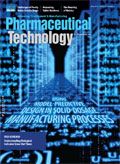Microwave Spectroscopy for Enantiomeric Detection of Chiral Molecules
Microwave spectroscopy overcomes some of the limitations of circular dichroism and vibrational circular dichroism in analyzing enantiomers.
Chirality plays an important role in pharmaceutical compounds, and methods for detecting and quantifying chirality remains challenging. Researchers at Harvard University and the Center for Free-Electron Laser Science (CFEL) and the Max Planck Institute in Germany recently reported on the use of enantiomer-specific detection of chiral molecules by microwave spectroscopy.
The researchers pointed out that the spectroscopic methods of circular dichroism and vibrational circular dichroism are commonly used in analyzing chiral molecules. These methods, however, have limitations in electric dipole approximation as the resultant weak effects produce weak signals and require high sample densities (1). In contrast, nonlinear techniques probing electric-dipole-allowed effects have been used for sensitive chiral analyses of liquid samples. Influenced by these methods, the researchers carried out nonlinear resonant phase-sensitive microwave spectroscopy of gas-phase samples in the presence of an adiabatically switched nonresonant orthogonal electric field. They used this technique to map the enantiomer-dependent sign of an electric dipole Rabi frequency onto the phase of emitted microwave radiation (1). They describe theoretically how this results in a sensitive and species-selective method for determining the chirality of cold gas-phase molecules. They implemented the approach experimentally to distinguish between the S and R enantiomers of 1,2-propanediol and their racemic mixture. They reported that this technique produced a large and definitive signature of chirality and has the potential to determine the chirality of multiple species in a mixture.
"We can soon measure mixtures of different compounds and determine the enantiomer ratios of each," said Melanie Schnell, co-author of the study in a CFEL release. In a next step, the researchers plan to apply the technique in a broadband spectrometer at CFEL that could then measure the enantiomer ratios in mixtures of substances. In the longer run, the method opens the door to develop a technique for separating enantiomers.
Reference
1. D. Patterson, Melanie Schnell, and John M. Doyle, Nature, 497 (7450), 475-477, 2013.

Drug Solutions Podcast: A Closer Look at mRNA in Oncology and Vaccines
April 30th 2024In this episode fo the Drug Solutions Podcast, etherna’s vice-president of Technology and Innovation, Stefaan De Koker, discusses the merits and challenges of using mRNA as the foundation for therapeutics in oncology as well as for vaccines.
Pharmaceutical Tariffs Are Imminent: How Industry is Bracing for Impact
April 16th 2025On April 14, 2025, the Trump Administration launched a national security-driven investigation into pharmaceuticals, a move that will likely result in tariffs being placed on pharmaceutical drugs, ingredients, and other components that are imported from outside of the United States.